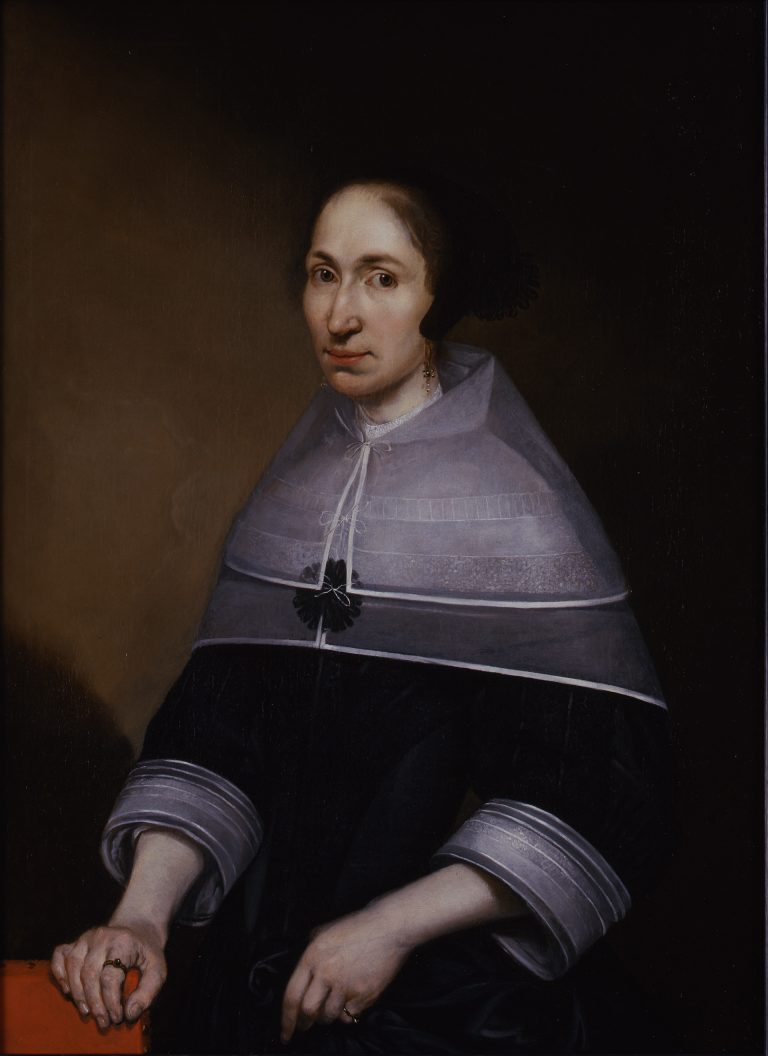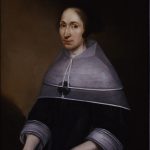This entry is about Willem Craeyvanger (1615/1616–after 1666) and Christine van der Wart (1620–1666). Click here to read about their children.
Willem Craeyvanger and Christine van der Wart of Arnhem had six sons and two daughters. In the seventeenth century, such a large family was unusual, because children often did not survive infancy (they did have one other daughter who died at a very young age). In the prime of their lives, the Craeyvangers had portraits painted of themselves and every one of their surviving children. Rather than commissioning a group portrait—which would have been an understandable alternative for a family with so many offspring—they chose instead to have individual portraits made. Willem and Christine are depicted half-length and nearly life-size in two pendant portraits.1
The portrait of Willem was produced in 1651 by Paulus Lesire (1612–54/56), a painter active in The Hague.2 His signature with the age of the sitter, “Aetatis 35,” appears in the left background. The accompanying portrait of Christine was not executed by Lesire. During the restoration of the painting carried out in 2009, the signature of Caspar Netscher (ca. 1639–84) was discovered, along with her age: “Aetatis 35” (at the left in the shadow, barely visible with the naked eye).3 Christine’s age reveals that her portrait dates from 1655 or 1656, since she was born in 1620.4
For the series of portraits of their children, the Craeyvangers chose an entirely different form of portraiture and a different format. The children were painted in about 1658 in a collaborative effort by Netscher and his teacher, Gerard ter Borch (1617–81), who portrayed them in pairs, grouped according to age, as pendants facing each other. The brothers and sisters are depicted three-quarter-length, standing, in painted ovals. This exceptional group of 10 portraits was inherited by the second son, Willem Craeyvanger, and subsequently passed down through the generations, remaining in the family for nearly 350 years.
The cloth merchant Willem Craeyvanger was 35 years old when he had himself portrayed by Lesire in 1651. A native of Arnhem, Craeyvanger had probably taken advantage of a visit to The Hague to have his portrait painted, presumably because in those years the thinly populated eastern part of the country, where he lived, lacked good portrait painters. The only well-known portraitist in Arnhem, Hendrik Coster (ca. 1620–64), had a rather stiff style that made a provincial impression.5 In comparison, Lesire’s fluently painted portrait of Willem Craeyvanger radiates stylish elegance.
People from the whole of the Dutch Republic, particularly from regions lacking good portraitists, had their portraits painted whenever they stayed for any length of time in The Hague. They might have been brought there for political reasons, such as representing their province at the meetings of the States General (the national assembly) or acting as a delegate to one of the other boards or colleges. In the seventeenth century, a number of the portrait painters active in The Hague had close ties to England and English patrons, and worked in a fashionable courtly style strongly influenced by Anthony van Dyck (1599–1641). In the 1640s and 1650s Adriaen Hanneman (ca. 1604–71), who had worked in Van Dyck’s studio in London, created a furor among the international courtly circles in The Hague with this elegant style of portraiture. Lesire, a native of Dordrecht, worked in The Hague from around 1643/44 until his death sometime after 1651.6 No more than a handful of his portraits from those years have survived.7 Whereas his early work, produced in Dordrecht, displays the influence of both Jacob Gerritsz Cuyp (1594–1652) and Rembrandt van Rijn (1606–69), in The Hague Lesire assumed the elegant style inspired by the popular Hanneman (fig 1).
Portrait of Willem Craeyvanger was painted swiftly with much attention to the details in Willem’s clothing, his shoulder-length hair and his graceful hands. He holds his left hand to his chest—a gesture perhaps intended to express his devotion to his wife—while reaching with his other hand toward the armrest of his chair. His hands are softly modeled, and his fingers are unnaturally long and graceful. His black cloak is draped over his right shoulder and arm. With his nonchalant hairstyle, thin moustache and goatee, Willem cuts a fashionable figure, though his small, flat collar and narrow cuffs do not suggest a taste for excessive finery. It is not known why Craeyvanger visited The Hague in 1651, but in any case he took home a valuable souvenir of his stay there: a portrait that seems to radiate an awareness of his prominence in society. Visitors to his house in Arnhem must have been impressed by his stylish depiction.
At the time of his visit to The Hague, Craeyvanger had been married to Christine van der Wart for 12 years, and she was expecting their seventh child. Gerrit, their youngest son, would be baptized on 4 December 1651 in the Grote Kerk in Arnhem.8 Perhaps this pregnancy was the reason she did not accompany her husband to The Hague. In any case, her likeness was not painted until some time after the completion of Willem’s portrait. Even so, it must have always been the intention to have her portrait painted as a pendant, because Lesire portrayed Willem turned toward her still-to-be-painted likeness. In the heraldic sense, he is on her dexter side, the position traditionally reserved for the man. In 1653 and 1655 the youngest Craeyvanger children were born—two girls, at last (an elder sister had died young)—after which time Christine’s portrait was painted. Although it would have been natural to have her pendant portrait done by the same artist, the Craeyvangers commissioned Caspar Netscher, who worked in nearby Deventer, to paint this work. The reasons for this decision are not known: maybe Lesire had already died by then or perhaps it was impossible for Christine to travel to Lesire’s studio in The Hague.
One might speculate that the Craeyvangers first approached Gerard ter Borch for Christine’s portrait since this renowned portraitist was not only Netscher’s teacher, but had also been working for Arnhem patrons since around 1653. In that year, for example, he had painted portraits of Willem Craeyvanger’s cousin Willem Everwijn and his wife, Johanna Kelffken.9 Perhaps Ter Borch was unwilling to paint a portrait that conformed to Lesire’s likeness of Willem—so unlike his own work in both scale and execution—and therefore passed the commission on to his talented pupil and studio assistant. Netscher grew up in Arnhem, where he had learned the rudiments of the trade from Coster, but he completed his training with Ter Borch soon after that master had moved to Deventer from his native Zwolle in 1654/55.10 Netscher would master the refined, small-figure style of his teacher and continue to work in Ter Borch’s studio until his departure for Bordeaux in 1659. After his return from France in 1662 he settled in The Hague, where he painted small-scale portraits for the rest of his career.
If the signature applied in light-colored paint to Christine’s portrait had not been discovered, one would hardly guess that Netscher was its maker, because its size is remarkably large compared with the rest of his oeuvre.11 The portrait of Christine of 1655 or 1656 is one of Netscher’s earliest known paintings and a remarkable addition to his early oeuvre.12 From 1655 onward Netscher occasionally signed his own paintings, even though he was still working under his teacher’s supervision. Evidently he had acquired a certain degree of independence in Ter Borch’s studio and was occasionally permitted to sign his own work. The lack of documentary evidence leaves us unenlightened with regard to the exact nature of the working relationship between Ter Borch and Netscher. In the seventeenth century, various kinds of contracts between teacher and pupil were possible, depending on such things as the pupil’s level of experience and financial means.13 It is not clear why Netscher signed the portraits of Christine and the youngest Craeyvanger children so faintly with a thin application of light-colored paint, making his name almost illegible. One might speculate that this was a deliberate attempt to disguise the fact that the pendants were executed by different artists.14
Clearly, Netscher did his best to ensure that Christine’s portrait matched Lesire’s likeness of Willem in scale, composition, palette, and its rather broad brushwork, though with the light falling onto the figure from the right instead of the left. The somewhat harsh light falling on her face, with a shadow providing a dark accent below the nose and a dark line dividing the lips, resembles Lesire’s portrayal of Willem. The background, too, is similar: both portraits display cast shadows and details executed in light brown paint, slightly reminiscent of cloudy skies. Netscher went on to use dark contours in the rendering of Christine’s hands; her right hand in particular was executed with rather pastose brushstrokes, which differ from Lesire’s soft modeling of Willem’s hands. Over her black dress Christine wears a double collar of translucent white linen that falls far below her shoulders. The lowest layer of the collar is decorated with strips of lace and tied closed with small white bows and a black rosette, as was the fashion in the 1650s.15 Her cuffs, too, consist of various transparent layers of starched linen. Christine holds up her dress with her left hand and rests her right hand on a red-upholstered armrest. Her hair is tied back beneath a black cap; long pendants inlaid with precious stones are attached to the ends of the cap brooch. Seen together, these pendants form a striking whole.
Who were Willem Craeyvanger and Christine van der Wart, who had themselves and their children immortalized with such apparent faith in the future? Since the discovery of their portraits in 2009, numerous details of their lives and their respective families have been found in the archives of Arnhem, Nijmegen and surroundings.16 The documentary evidence suggests that the couple—both typical representatives of the upper middle class—prospered for a long time, and that Willem Craeyvanger played a prominent role in Arnhem’s public life. Willem, the third son of Johan Craeyvanger and Naleken Sluisken, must have been born in 1615 or 1616, according to the inscription on his portrait. Christine van der Wart was a native of Nijmegen, where she was baptized in the Stevenskerk on 16 September 1620.17 Christine’s mother was the daughter of Peter Verstegen, town secretary of Arnhem; one of her mother’s brothers was married to an aunt of Willem. Evidently Willem had become acquainted with his bride in the family circle. Willem and Christine, both from Protestant families, married on 20 November 1639.
In 1640, at the age of 24, Willem Craeyvanger was first appointed to public office in Arnhem,18 after which he steadily climbed the social ladder. Many important posts were to follow, though he never secured a top administrative office as magistrate or burgomaster. He held various offices in, for instance, the Guild of St. Nicholas—the merchants’ guild, whose 400 members made it the largest guild in the city. He also fulfilled administrative functions in one of Arnhem’s civic militias,19 organizations originally intended to help defend the city. In addition, he was a member of the elite St. Joost civic militia. Between 1644 and 1663, he served twice as deacon of the Reformed Church and afterwards was twice appointed an elder.20 For Craeyvanger, an important step upward was his honorable appointment in 1647 to membership in the prestigious Brotherhood of St. Nicholas, a charitable organization that administered poor relief. This appointment occurred several years before he had his portrait painted in 1651.
In 1662 Craeyvanger was appointed by the town council to the office of town treasurer, after working for three years as assistant to the previous treasurer; one of his duties in this capacity was to collect various city taxes. This post could have been a stepping-stone to higher government offices, but Craeyvanger overplayed his hand. Although he was rather wealthy—for one reason because he had inherited money from both his own family and that of his wife—financial recklessness got him into trouble. In the end he lost his fortune, and as a result his social position.
In March 1666 Craeyvanger went bankrupt and absconded from Arnhem, leaving his wife and children behind, destitute. His possessions largely went to his creditors, except for the family portraits, which apparently had no monetary value to outsiders. To compound the family’s misfortunes, Christine died five months after her husband declared bankruptcy. She was possibly a victim of the plague, which swept through Arnhem in August 1666. The children, then between the ages of 11 and 25, could not even afford the few guilders needed to have the church bells rung at her burial. The stricken family fell apart, but their portraits remained together. Inherited by the second son, Willem, they were passed down from one generation to the next for more than three centuries.


